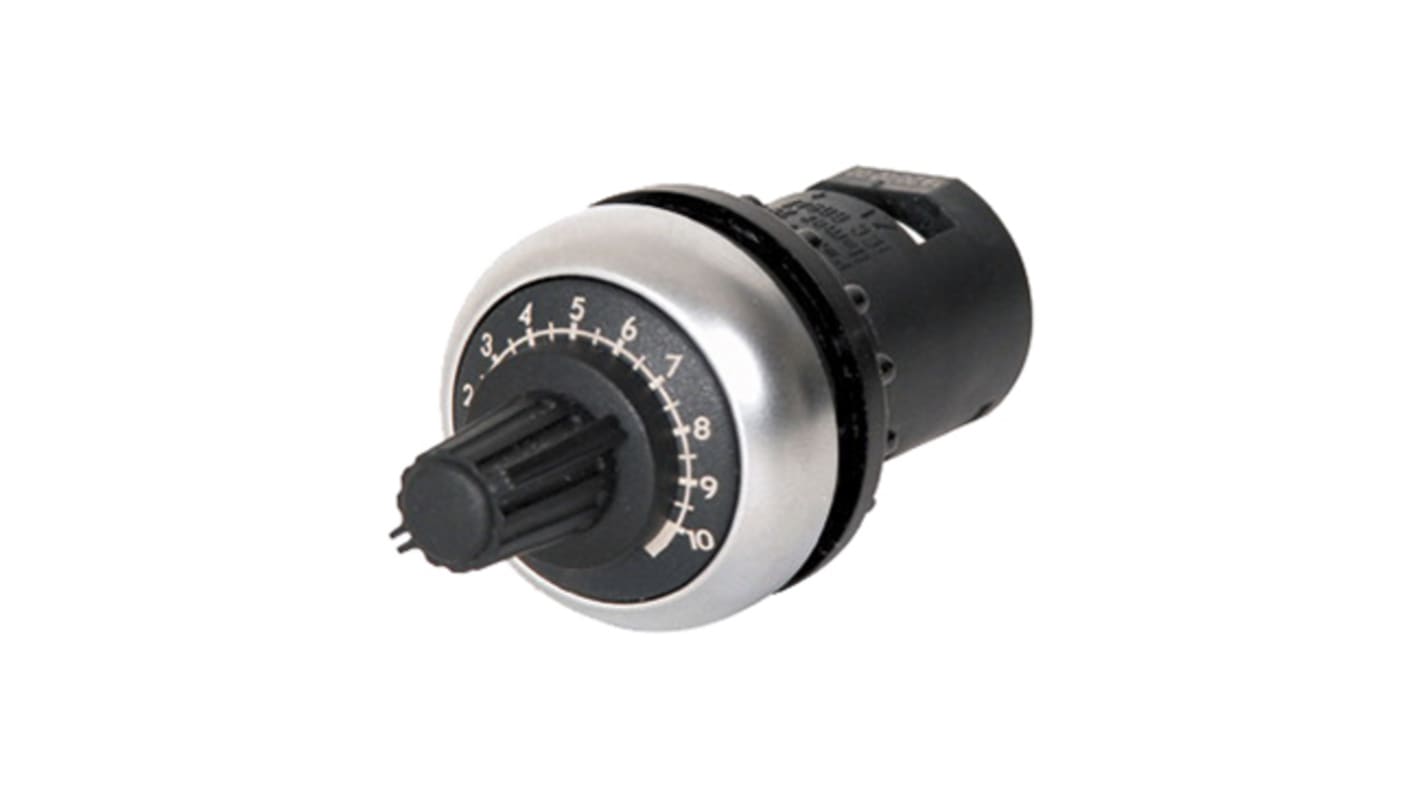Eaton 4.7kΩ Rotary Potentiometer Front Mount, 232232 M22S-R4K7
- RS Stock No.:
- 110-4564
- Mfr. Part No.:
- 232232 M22S-R4K7
- Manufacturer:
- Eaton
Price (VAT excluded) Each
TWD2,653.00
(exc. GST)
TWD2,785.65
(inc. GST)
Stock check temporarily unavailable - call for stock availability
FREE delivery for orders over TWD2,857.00 (ex VAT)
Units | Per unit |
|---|---|
| 1 + | TWD2,653.00 |
- RS Stock No.:
- 110-4564
- Mfr. Part No.:
- 232232 M22S-R4K7
- Manufacturer:
- Eaton
- COO (Country of Origin):
- HU
Potentiometer
Eaton’s M22 range of rotary potentiometers enable a user to regulate and change the current that flows through a circuit, these rotary potentiometers can be easily controlled by turning the adjustable spindle or knob. These potentiometers are panel mount with screw terminals for easy mounting inside control panels and other electronics.
Features & Benefits
Panel mounting
Rotary action twist to set value
IP66 rating
Selection of ranges
Rotary action twist to set value
IP66 rating
Selection of ranges
What is a Potentiometer?
A potentiometer is a variable resistor that increases or decreases the resistance in an application. Usually available as either digital or analogue, there are many different types of potentiometer but the two main types are rotary and linear.
• Linear - comes in a rectangle strip shape and can be pulled up or down for the required resistance, used a lot within sound systems for mic output or volume control.
• Rotary - the shaft is housed by a knob, you would find these on dimmer switches or speakers, and turning (usually to the right) will increase the resistance amplifying the output, whether that is light, sound or voltage.
• Linear - comes in a rectangle strip shape and can be pulled up or down for the required resistance, used a lot within sound systems for mic output or volume control.
• Rotary - the shaft is housed by a knob, you would find these on dimmer switches or speakers, and turning (usually to the right) will increase the resistance amplifying the output, whether that is light, sound or voltage.
How do Potentiometers work?
Potentiometers have two terminals that are fixed to a resistive element (the track). The resistive element is typically wire wound or made from carbon, cermet or conductive plastic. The third terminal is connected to the wiper, which is a sliding contact. As the wiper moves along the track, the resistance changes and the current flowing through the circuit changes.
Approvals
UL, CSA.
Standards
IEC/EN60947.
Eaton RMQ Titan Rotary Potentiometer, 4.7 kΩ - RMQ-Titan / M22S Series - M22S-R4K7
This Eaton rotary potentiometer regulates the current that flows through an electric circuit. It features an adjustable spindle that uses precision twist-action to set its value and increase or limit the resistance and output. The unit is commonly used in circuits to control audio volume, lighting intensity and temperature. This potentiometer has a rating of IP (ingress protection) 66, which means it's dust-tight and protected from low-pressure jets of water.
• ATEX (explosive atmospheres) certification for safety in hazardous areas
• Shaft length of 32.9 mm and diameter of 29.5 mm for easy handling
• Maximum resistance of 4.7 kΩ offers powerful range
• Front mount with a 22 mm diameter mounting hole for simple and versatile installation
• Shaft length of 32.9 mm and diameter of 29.5 mm for easy handling
• Maximum resistance of 4.7 kΩ offers powerful range
• Front mount with a 22 mm diameter mounting hole for simple and versatile installation
How do potentiometers work?
Potentiometers have three terminals. Two of them are fixed to a resistive element such as wound wire, carbon or conductive plastic. The third terminal is connected to a wiper. As the wiper moves along its track, the resistance changes, increasing or decreasing the circuit's current.
What's the difference between a rotary potentiometer and a linear potentiometer?
Both are three-terminal resistors that help control electric current flow. A linear potentiometer, instead of using a rotating knob or spindle to control the current, features a sliding contact and a linear resistor.
Note
Eaton formerly known as Moeller
Attribute | Value |
|---|---|
| Potentiometer Type | Rotary |
| Maximum Resistance | 4.7kΩ |
| Power Rating | 0.5W |
| Mounting Type | Front Mount |
| Termination Style | Screw |
| Shaft Length | 32.9mm |
| Shaft Diameter | 29.5 mm |
| Series | RMQ-Titan |

